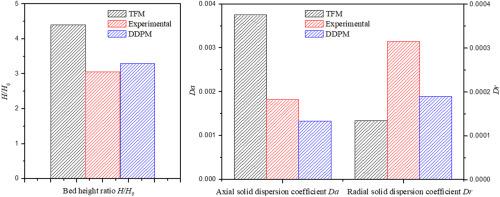双流体模型与致密离散相模型在纳米颗粒团块鼓泡流化模拟中的比较研究
IF 4.3
2区 材料科学
Q2 ENGINEERING, CHEMICAL
引用次数: 0
摘要
在本研究中,比较了双流体模型(TFM)和致密离散相模型(DDPM)在模拟纳米颗粒团块鼓泡流化过程中的数值性能。研究并比较了网格尺寸、镜面系数、恢复系数、反射系数和阻力模型对两种方法的影响。网格大小分析结果表明,DDPM比TFM产生更好的网格无关解。敏感性分析表明,子模型参数主要影响近壁面区域的局部流动行为,而阻力模型对两种方法的整体流体力学行为都有主要影响。TFM预测了床层内的环心流动,但过度预测了床层膨胀高度和轴向固体分散系数。DDPM预测的床层高度比和固体分散系数与实验数据更加接近,而DDPM内流场表现为多次内循环,固体浓度呈不规则径向波动。本文章由计算机程序翻译,如有差异,请以英文原文为准。

Comparative study of the two-fluid model and the dense discrete phase model for simulations of bubbling fluidization of nanoparticle agglomerates
In this study, the numerical performance of the two-fluid model (TFM) and the dense discrete phase model (DDPM) for simulations of bubbling fluidization of nanoparticle agglomerates is compared. The effects of grid size, specularity coefficient, restitution coefficient, reflection coefficient, and drag models are investigated and compared for the two approaches. The grid size analysis results indicate that the DDPM generates a better grid-independent solution than the TFM. The sensitivity analyses show that sub-model parameters mainly affect the local flow behavior at the near-wall zone, while the drag models show a major effect on the overall hydrodynamics behavior for both approaches. The TFM predict the annular-core flow in the bed, but over-predict the bed expansion height and the axial solid dispersion coefficient. The bed height ratio and solid dispersion coefficients predicted by the DDPM are more closely aligned with the experimental data, while the flow fields in the DDPM exhibit multiple internal circulations, and the solid concentration show irregular radial fluctuations.
求助全文
通过发布文献求助,成功后即可免费获取论文全文。
去求助
来源期刊

Particuology
工程技术-材料科学:综合
CiteScore
6.70
自引率
2.90%
发文量
1730
审稿时长
32 days
期刊介绍:
The word ‘particuology’ was coined to parallel the discipline for the science and technology of particles.
Particuology is an interdisciplinary journal that publishes frontier research articles and critical reviews on the discovery, formulation and engineering of particulate materials, processes and systems. It especially welcomes contributions utilising advanced theoretical, modelling and measurement methods to enable the discovery and creation of new particulate materials, and the manufacturing of functional particulate-based products, such as sensors.
Papers are handled by Thematic Editors who oversee contributions from specific subject fields. These fields are classified into: Particle Synthesis and Modification; Particle Characterization and Measurement; Granular Systems and Bulk Solids Technology; Fluidization and Particle-Fluid Systems; Aerosols; and Applications of Particle Technology.
Key topics concerning the creation and processing of particulates include:
-Modelling and simulation of particle formation, collective behaviour of particles and systems for particle production over a broad spectrum of length scales
-Mining of experimental data for particle synthesis and surface properties to facilitate the creation of new materials and processes
-Particle design and preparation including controlled response and sensing functionalities in formation, delivery systems and biological systems, etc.
-Experimental and computational methods for visualization and analysis of particulate system.
These topics are broadly relevant to the production of materials, pharmaceuticals and food, and to the conversion of energy resources to fuels and protection of the environment.
 求助内容:
求助内容: 应助结果提醒方式:
应助结果提醒方式:


